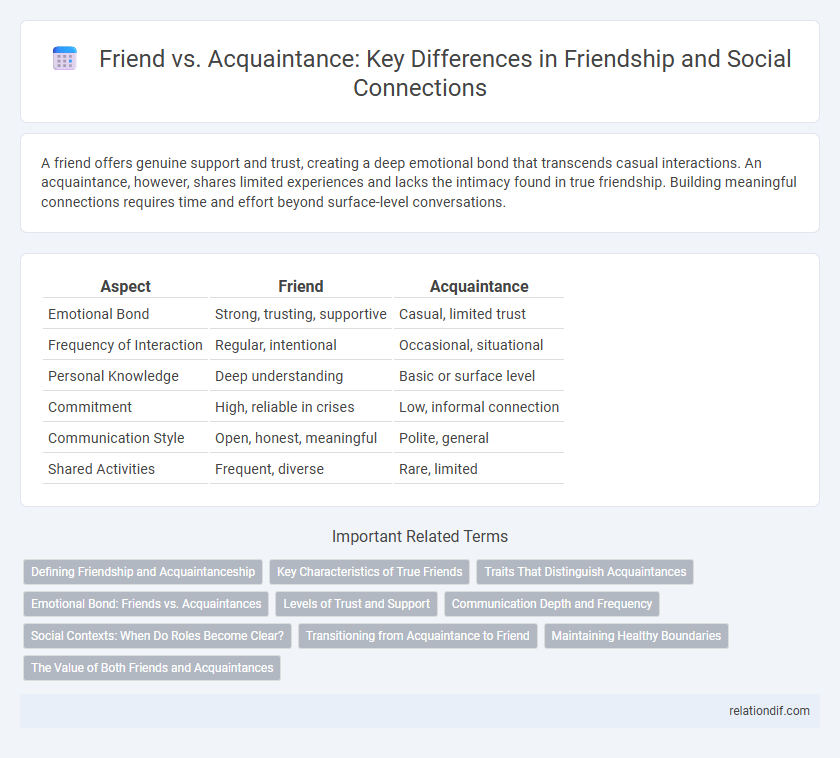A friend offers genuine support and trust, creating a deep emotional bond that transcends casual interactions. An acquaintance, however, shares limited experiences and lacks the intimacy found in true friendship. Building meaningful connections requires time and effort beyond surface-level conversations.
Table of Comparison
| Aspect | Friend | Acquaintance |
|---|---|---|
| Emotional Bond | Strong, trusting, supportive | Casual, limited trust |
| Frequency of Interaction | Regular, intentional | Occasional, situational |
| Personal Knowledge | Deep understanding | Basic or surface level |
| Commitment | High, reliable in crises | Low, informal connection |
| Communication Style | Open, honest, meaningful | Polite, general |
| Shared Activities | Frequent, diverse | Rare, limited |
Defining Friendship and Acquaintanceship
Friendship involves a deep emotional connection, mutual trust, and consistent support, distinguishing it from mere acquaintanceship, which is characterized by casual interactions and limited personal knowledge. Friends actively engage in shared experiences and provide meaningful encouragement, whereas acquaintances maintain superficial communication without significant emotional involvement. Understanding these differences helps clarify social bonds and prioritizes relationships that contribute positively to emotional well-being.
Key Characteristics of True Friends
True friends demonstrate unwavering trust, deep emotional support, and consistent reliability, distinguishing them from mere acquaintances who often maintain superficial interactions. They actively invest time and effort to understand and uplift each other, fostering genuine connection beyond casual conversations. Loyalty and mutual respect form the foundation of true friendship, enabling resilience through challenges and shared growth.
Traits That Distinguish Acquaintances
Acquaintances typically exhibit limited emotional depth and trust compared to friends, often maintaining surface-level interactions without significant personal disclosure. They are characterized by infrequent communication and situational connections, such as coworkers or neighbors, where interactions revolve around specific contexts rather than mutual support. The absence of vulnerability and consistent emotional investment differentiates acquaintances from genuine friendships, highlighting boundaries in commitment and intimacy.
Emotional Bond: Friends vs. Acquaintances
Friends share a deep emotional bond characterized by trust, empathy, and mutual support, fostering a sense of belonging and security. Acquaintances maintain a more superficial connection, often limited to casual interactions without significant emotional investment. This distinction in emotional depth defines the quality and durability of relationships within social networks.
Levels of Trust and Support
Friends exhibit higher levels of trust and provide consistent emotional support, creating a reliable bond that fosters mutual understanding and loyalty. Acquaintances typically maintain limited trust and offer minimal support, often interacting in casual or situational contexts without deep personal connection. The distinction lies in the depth of trust and the readiness to offer help during challenging times, which is significantly stronger in friendships than in acquaintanceships.
Communication Depth and Frequency
Friendship involves deeper communication characterized by frequent, meaningful interactions that foster emotional connection and trust. In contrast, acquaintances maintain more superficial exchanges with sporadic communication, often limited to casual or situational topics. The depth and regularity of communication serve as key factors distinguishing true friends from mere acquaintances.
Social Contexts: When Do Roles Become Clear?
Friend roles become clear in social contexts involving emotional support, shared experiences, and mutual trust, whereas acquaintances typically engage in casual interactions limited to surface-level conversations. Settings such as group gatherings, collaborative projects, or crisis situations often reveal the depth of relational bonds by highlighting consistent reciprocal care and understanding. Distinctions emerge as frequency and quality of interaction increase, solidifying friendships beyond mere familiarity.
Transitioning from Acquaintance to Friend
Building trust and shared experiences are essential when transitioning from acquaintance to friend, as these elements deepen emotional connection and understanding. Regular communication and vulnerability help establish a foundation of reliability and support, distinguishing a true friend from a mere acquaintance. Engaging in meaningful activities together fosters mutual respect and intimacy, reinforcing the bond beyond casual interaction.
Maintaining Healthy Boundaries
Maintaining healthy boundaries between friends and acquaintances involves clearly defining emotional investment and time commitments to protect personal well-being. Friends typically share deeper trust and mutual support, requiring more frequent communication and vulnerability, whereas acquaintances benefit from polite distance and limited personal disclosure. Establishing these boundaries enhances relationship quality and prevents misunderstandings or emotional exhaustion.
The Value of Both Friends and Acquaintances
Friends provide deep emotional support, trust, and meaningful connection essential for mental well-being, while acquaintances offer diverse social interactions and networking opportunities that broaden perspectives. Both relationships contribute uniquely to personal growth, with friends fostering intimacy and acquaintances enhancing social versatility. Recognizing the value in each encourages balanced social dynamics and resilience.
Friend vs Acquaintance Infographic

 relationdif.com
relationdif.com